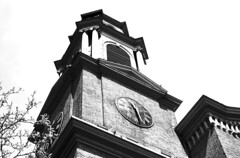
First Church, Albany (Photo credit: carljohnson)
In old Albany, the Dutch Church was the primary provider of social services to the needy of the community, including tending to the care of the poor. Joel Munsell preserved the record of the burial of Ryseck Swart, a pauper in the church’s care:
“I can’t refrain from giving an instance of the expense of burying a church pauper. On the 15th of February, 1700, Ryseck, widow of Gerrit Swart, the last survivor of the church poor at that date, died and was buried on the 17th, the expenses of which are copied from the deacon’s book. It is entered in Dutch, but I think you will be content with English: Three dry boards for the coffin, 7 guilders 10 stuivers; 3/4 lb. nails, 1g. 10s.; making the coffin, 24g.; cartage, 10s.; a half vat and an anker* of good beer 27g.; one gallon of rum, 21g.; 6 gall. Madeira for women and men, 84g.; sugar and spices, 5g.; 150 sugar cakes, 15g.; tobacco and pipes, 4g.10s.; digging the grave, 30g.; use of the pall, 12g.; inviting to the funeral, 12g.; Mary Lookermans was paid 6g. for assistance at the burial, and Marritje Lieverse for nursing 39g. Total 289 g., or $115.60. The expenses of maintaining this person four years had been 2,229 guilders 10 stuyvers.
*An anker was 10 gallons, and a half vat about 11 gallons. Good beer was strong beer, ale. A guilder was nearly 40 cts. and a stuyver was nearly 2cts.“
Apparently little expense was spared, at least in the celebratory aspects of the funeral service . . . beer, rum, and port, not to mention sugar cakes and tobacco. It’s often said that the funeral is more about the living than the dead.


Leave a Reply